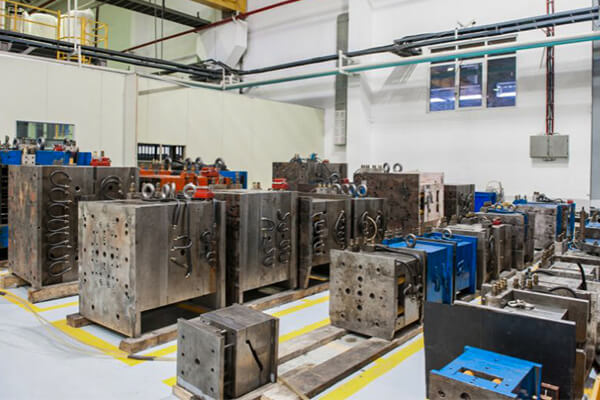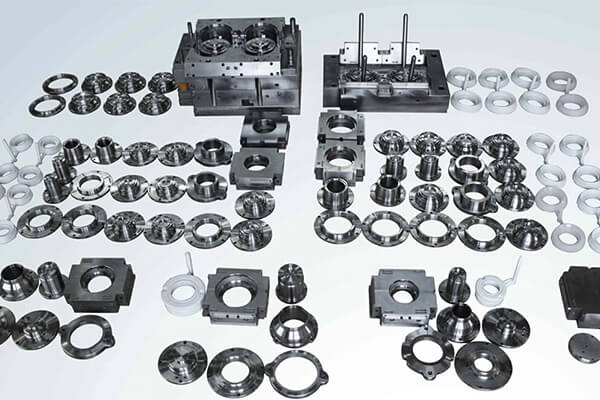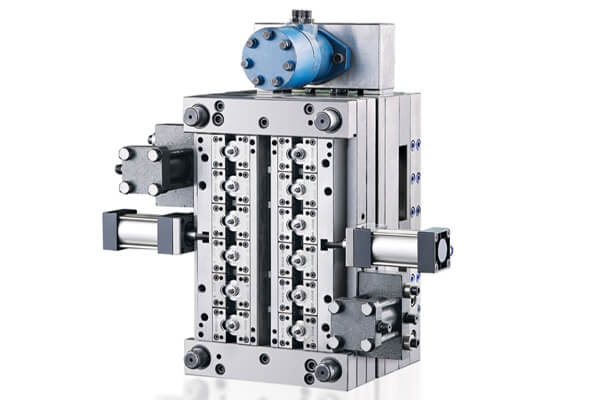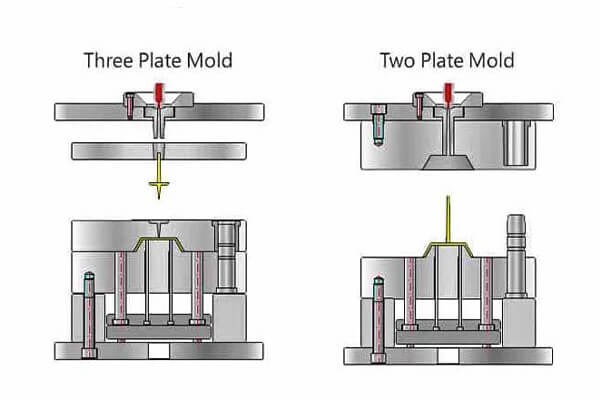Injection Molding Mold Types: Tooling For Custom Parts
There are lots of injection molding mold types. Common injection molding mold types include single-cavity, multi-cavity, family, hot runner, cold runner, and more, which are generally aluminum molds or steel molds.
Injection molding mold types reflect the diversity of the injection molding process and can meet various production requirements and product designs.
Sungplastic is an injection molding mold manufacturer and can provider different injection molding mold types for you.
If you are looking for mold fabrication solution, please read more.

Low/High Cavitation
Single-cavity molds are designed to produce one part per cycle, offering a cost-effective solution, especially when dealing with low part volumes. They are more budget-friendly to construct and have shorter lead times. However, their drawback lies in the higher per-piece production cost in molding.
Multi-cavity molds, on the other hand, yield multiple parts in a single cycle. Their primary advantages include increased production capacity and lower per-piece production costs due to the ability to manufacture more parts within a comparable cycle time.
Family Mold
A family mold shares a single mold base but features two or more distinct cavities, enabling the production of different parts simultaneously or with the option to isolate production to specific cavities using shut-offs. For optimal results in molding, it’s advisable for the parts to be similar in size, shape, resin type, and expected production volumes, especially if the intent is to manufacture all parts concurrently. Automation may be required to separate the pieces during or after production.
If mold cost is a significant consideration and production volumes are low, a family mold can offer cost savings and versatility.

Unscrewing Molds
Also known as a threaded mold or rotating core mold, it is one of injection molding mold types, specifically designed to create parts with threaded features, such as screw threads. Unscrewing molds represent the most common method for incorporating threaded holes into plastic parts. These molds employ automated systems with small drive mechanisms (such as rack & pinion, electric, or hydraulic motors) linked to the manufacturing process. These mechanisms rotate threaded features to extract undercut features. Threads can be either internal or external, and the extraction process is synchronized with the press cycle.
Multi-shot/multi-component tooling allows product designers to use two or more dissimilar materials within the same part during a single cycle. Various factors, including different physical properties or purely aesthetic considerations, may justify using different materials. Such molds often employ multiple manifolds within a single tool. Multi-shot tooling can provide an elegant solution for complex products and accommodate color changes within a product line.
Running multi-shot tooling requires specialized presses and molds. It may necessitate multiple machine nozzles, hot runner systems, and mold rotation. While we currently do not have multi-shot molding presses on our premises, we excel in designing and constructing these intricate tools, a skill we have honed over decades.

Hot Runner Molds
Hot runner molds employ temperature-controlled manifolds to significantly reduce or eliminate waste material (runners) during the molding cycle. Injection points can be located outside the part or directly into it. This approach can substantially enhance cycle times, as the sprue or runner system often dictates the mold cycle duration. Eliminating runners also saves valuable material.
Hot runner molds require a press-specific temperature controller, sized to match the manifold in the mold. Some maintenance costs associated with hot runner tools may be higher, but they often pay for themselves over time through material and cycle time savings. This is particularly relevant for applications involving expensive engineering-grade resins or high annual production volumes.
Cold Runner Molds
Cold runner molds represent a more conventional approach, utilizing sprues and runners to gate into the part. While this method is typically less complex, it may result in larger amounts of wasted material and slower production cycles. Depending on the application, a portion of the wasted material can be re-ground and re-processed for future use, but this might impact the physical properties of the resin.
Dealing with advanced, high-cost materials like engineering and medical-grade resins or facing constraints on regrind usage in your application may make a more efficient hot runner mold a preferable choice for your project.
Insulated Runner Molds
Insulated runner tools resemble traditional cold runner molds but incorporate cartridge heaters or other heating methods to create a surrounding layer of molten resin, forming an insulated “cull.” This achieves a similar effect to a hot runner system but at a lower cost, as it eliminates the need for a temperature controller. Additionally, it allows for quicker color and material changes. However, insulated runners may not be suitable for all materials and tend to be less compatible with demanding engineering-grade resins.
Two/Three Plate Molds
Three-plate molds are essentially cold runner molds, but the addition of a third plate in the runner system provides the flexibility to position the injection point virtually anywhere on the tool. This approach is usually more cost-effective than implementing a hot runner system. However, these molds often feature larger and more unwieldy runners, making automation a more challenging task.

Composite Mold
Composite molds are one of the injection molding mold types used to manufacture composite parts that contain multiple different materials. These molds typically require precise control systems to ensure that different materials are injected in the correct locations and times to produce the final composite product.
Rotational Mold
Rotational molds are one of the injection molding mold types used to manufacture hollow or large plastic parts, such as tanks, barrels, and toys. These molds evenly distribute plastic powder inside the mold and then rotate the mold to melt and solidify the plastic inside, forming the desired shape.
Foam Mold
Foam molds are one of the injection molding mold types used to manufacture foam plastic products, such as foam boards, foam containers, and foam packaging materials. These molds inject an expanding agent during the injection process to create bubbles in the plastic, resulting in lightweight and well-insulating foam products.
Temperature-Sensitive Mold
Temperature-sensitive molds allow for temperature control of the material during the injection process to achieve specific performance or appearance effects. These molds are suitable for applications that require precise control of material temperature, such as certain medical devices or the casings of electronic products.
Large Mold
Large molds are one of the injection molding mold types used to manufacture large plastic parts or products, such as automotive components, large containers, and the enclosures of industrial equipment. They typically require powerful injection machines and manufacturing processes.
Embossing Mold
Embossing molds are one of the injection molding mold types used to add textures, patterns, or logos to plastic parts. These molds can enhance the appearance of parts and are suitable for products that require custom designs or branding.
How to Choose Injection Molding Mold Types
Choosing one of the right injection molding mold types is a critical decision that can significantly impact the quality, cost, and efficiency of your plastic product manufacturing process. Here are considerations to help you choose the appropriate injection molding mold types.
Clearly define your product’s specifications, including size, shape, material, color, design complexity and any special features or requirements. Complex parts may require specialized molds.
Consider the expected production volume of your product. This will influence the choice of mold type and construction.
Choose one of the most suitable injection molding mold types based on your product and production needs.
Select the appropriate injection molding mold types material based on factors like the type of plastic material you’ll be using, production volume, and expected tool life. Common mold materials include steel and aluminum.
Consider initial mold costs, production costs, and expected product lifespan. Different injection molding mold types and materials have varying costs. Balance cost considerations with quality and efficiency.
Some molds may have longer lead times for design, fabrication, and delivery. Ensure that the mold can be ready within your desired timeframe.
Sungplastic: Mold Fabrication Solution for You
Our mold fabrication solutions include:
Rapid tooling manufacturing
Rapid prototype mold fabrication
Injection mold fabrication
Thermoforming Tooling
Custom silicone molds manufacturing
We are good at manufacturing different injection molding mold type for producing custom parts. Besides, we also provide custom parts manufacturing services, like CNC machining, injection molding, 3D printing, casting and so on.
Contact us directly if needed! Hope our specialization can help with your project!
Get a free quote and design analysis today.
We’ll reply to you within 6 working hours.
We respect your privacy.
+86 139 2927 4777 (WhatsApp, Wechat)
